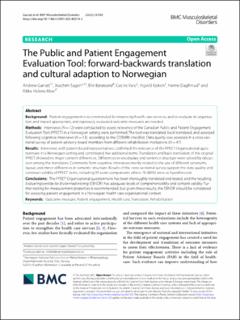| dc.contributor.author | Garratt, Andrew | |
| dc.contributor.author | Sagen, Joachim Støren | |
| dc.contributor.author | Børøsund, Elin | |
| dc.contributor.author | Varsi, Cecilie | |
| dc.contributor.author | Kjeken, Ingvild | |
| dc.contributor.author | Dagfinrud, Hanne | |
| dc.contributor.author | Moe, Rikke Helene | |
| dc.date.accessioned | 2023-02-20T09:49:32Z | |
| dc.date.available | 2023-02-20T09:49:32Z | |
| dc.date.created | 2022-09-13T09:50:13Z | |
| dc.date.issued | 2022 | |
| dc.identifier.citation | BMC Musculoskeletal Disorders. 2022, 23 (1), . | |
| dc.identifier.issn | 1471-2474 | |
| dc.identifier.uri | https://hdl.handle.net/11250/3052245 | |
| dc.description.abstract | Background: Patient engagement is recommended for improving health care services, and to evaluate its organisa- tion and impact appropriate, and rigorously evaluated outcome measures are needed. Methods: Interviews (N = 12) were conducted to assess relevance of the Canadian Public and Patient Engagement Evaluation Tool (PPEET) in a Norwegian setting were performed. The tool was translated, back translated, and assessed following cognitive interviews (N = 13), according to the COSMIN checklist. Data quality was assessed in a cross-sec- tional survey of patient advisory board members from different rehabilitation institutions (N = 47). Results: Interviews with patient board representatives confirmed the relevance of the PPEET Organisational ques- tionnaire in a Norwegian setting and contributed five additional items. Translation and back translation of the original PPEET showed no major content differences. Differences in vocabulary and sentence structure were solved by discus- sion among the translators. Comments from cognitive interviews mainly related to the use of different synonyms, layout, and minor differences in semantic structure. Results of the cross-sectional survey support the data quality and construct validity of PPEET items, including 95 score comparisons where 76 (80%) were as hypothesized. Conclusions: The PPEET Organisational questionnaire has been thoroughly translated and tested, and the resulting Evalueringsverktøy for Brukermedvirkning (EBNOR) has adequate levels of comprehensibility and content validity. Fur- ther testing for measurement properties is recommended, but given these results, the EBNOR should be considered for assessing patient engagement in a Norwegian health care organisational context | |
| dc.language.iso | eng | |
| dc.title | The Public and Patient Engagement Evaluation Tool: forward-backwards translation and cultural adaption to Norwegian | |
| dc.title.alternative | The Public and Patient Engagement Evaluation Tool: forward-backwards translation and cultural adaption to Norwegian | |
| dc.type | Peer reviewed | |
| dc.type | Journal article | |
| dc.description.version | publishedVersion | |
| dc.source.pagenumber | 11 | |
| dc.source.volume | 23 | |
| dc.source.journal | BMC Musculoskeletal Disorders | |
| dc.source.issue | 1 | |
| dc.identifier.doi | 10.1186/s12891-022-05514-3 | |
| dc.identifier.cristin | 2051066 | |
| cristin.ispublished | true | |
| cristin.fulltext | original | |
| cristin.qualitycode | 1 | |
